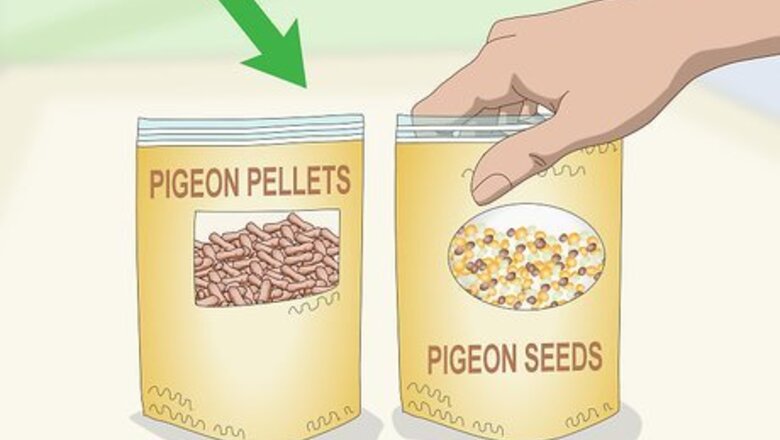
views
Choosing Healthy Grains
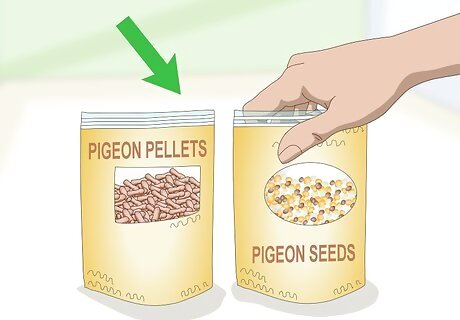
Purchase a commercial seed or pellet blend. All commercial pigeon foods are blends of various grains. Although most people reach for bread to toss to wild pigeons, the difference is that commercial feed is raw and made out of more nutritious grain than your average hot dog bun. You can usually find pigeon-formulated commercial feed online or at feed stores rather than pet stores. Pellets are considered to be the ideal pigeon food because they have nutrients like calcium that seeds lack. However, seed blends are fine if you can’t find pellets. When buying seed or pellet blends, check the label to make sure they are professionally-formulated and nutritionally-balanced.
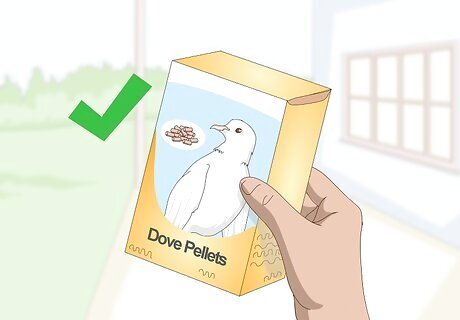
Use dove seed and pellet blends if you can’t find pigeon food. Given that both of these city-living species are from the same bird family, they have similar diets. Any dove food makes for a healthy substitute when pigeon food isn’t available. It is completely safe and nutritious for pigeons. Pigeon and dove diets are so similar that, in fact, some commercial blends are labeled as safe for both pigeons and doves. Dove food may be available in some pet stores.
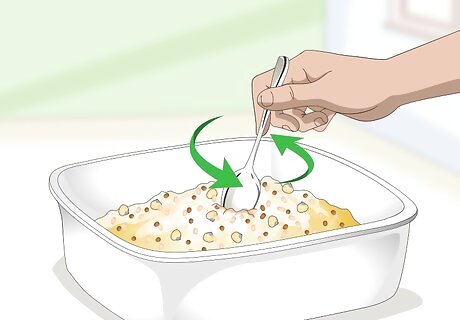
Mix your own raw grains if you don’t have commercial blends. Making your own pigeon food isn’t difficult, although you need to track down several raw grains. For a basic blend, try mixing equal amounts of wheat, sorghum, millet, corn, red lentils, and rice. You may be able to find these ingredients at grocery stores or order them online. You can then store the mix in airtight plastic containers. You don’t need to cook the ingredients! A good blend doesn’t require a lot of preparation. Components like raw corn kernels and rice are perfectly safe and nutritious for pigeons. Each ingredient has a different amount of fat, protein and nutrients, so blending them creates a balanced food for pigeons. Corn and wheat, for instance, are nutritious but fatty, so blending them with foods like rice helps prevent your birds from getting too plump.
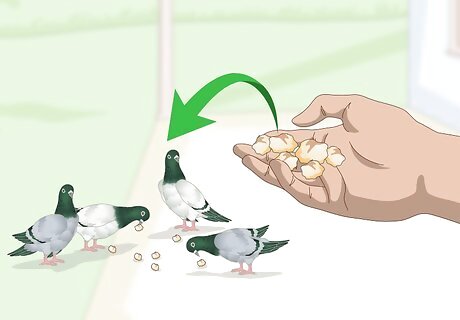
Give out bread sparingly as a snack. When pigeons gather, most people reach for the bread. Birds love bread, but the problem is that bread is empty calories to them. It has no nutritional value. In addition, it can take on mold easily and attract pests like rats. Stick to raw grains as much as possible whether you’re feeding wild or domesticated pigeons. If you give pigeons bread, try to choose an unbleached or unrefined whole wheat bread. Dampen it in water and crumble it up into tiny pieces.
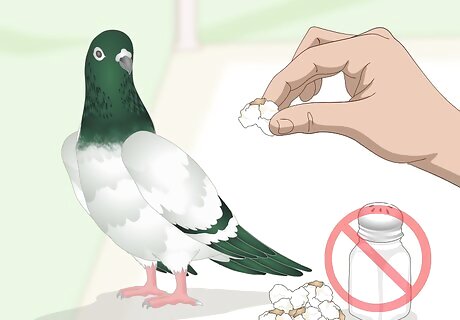
Feed pigeons unsalted popcorn for a safe snack. Uncooked corn kernels are a nutritious food choice for pigeons, so popcorn is a good alternative to bread. You do need to be careful about what kind of popcorn you give them, however. Lay off the salt and butter. High quantities of salt and other ingredients tend to be toxic to birds. A lot of microwavable popcorn has harmful artificial ingredients in it, so keep this in mind before heating up a bag. Check the ingredients on the label.
Using Other Nutritious Foods
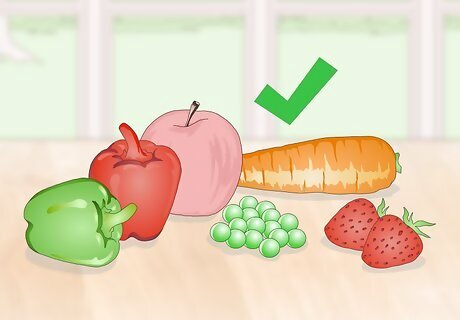
Select some nutritious fruits and vegetables. Good fruit and vegetable choices are colorful and aren’t mostly water. Some examples include fruits and vegetables like apples, peas, romaine lettuce, bell peppers, strawberries, and carrots. Pale greens with a high water content, such as iceberg lettuce and celery, should be avoided. Most fruits and vegetables are safe for pigeons except for avocados, which may be toxic. Try to provide a variety of foods for your pigeons to balance out their diet.
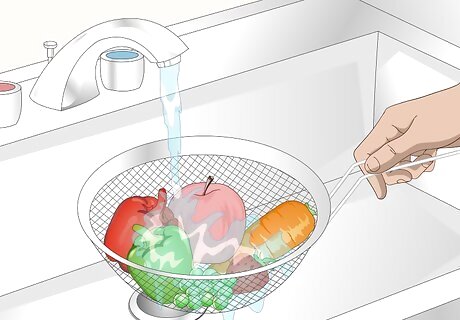
Wash the fruits and vegetables without peeling them. That’s right, pigeons don’t mind if you leave the skin on. They aren’t quite as picky as some kids you know. Before cutting any piece of fruit or vegetable, rinse it off first under running water to clear away chemicals and debris. Be careful with fruits that contain small stones, such as cherries. Remove these stones first to prevent pigeons from swallowing them. They will also be easier to cut once the pits are gone.
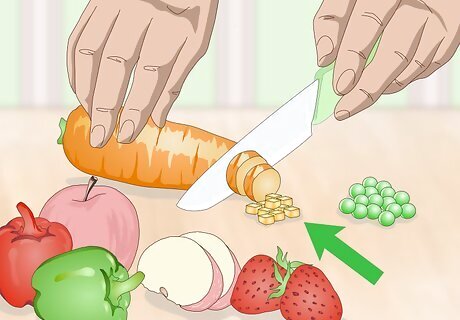
Cut fruits and vegetables up into bite-sized pieces. Chop up everything into pieces that are smaller than the bird’s beak, especially when baby pigeons are around. The bigger the bird, the bigger you can leave the pieces. Avoid trying to give pigeons full-sized fruits or vegetables. Chances are you will have an uneaten mess by the next morning.
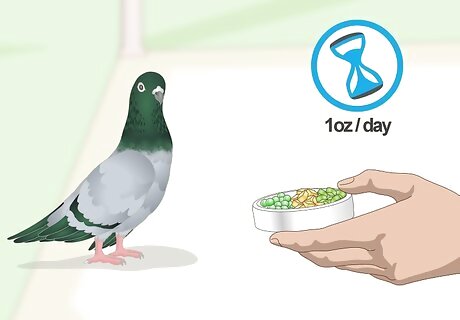
Serve pigeons 1 oz (28 g) of fruits and vegetables a day. Put the fruits and vegetables in a separate, clean container if you’re feeding pigeons at home. You will need to provide about 2 tablespoons (30 ml) of food for each bird. Keep the amount of fruits and vegetables equal to the amount of grain you provide. If any of the food goes uneaten, throw away leftovers and reduce the amount of food you provide the next day. At a minimum, pigeons should be given fresh fruits and vegetables 3 to 4 times a week. Like small children, pigeons may refuse to eat some foods, but keep trying. Eventually they will eat it. If you notice your pigeons have a favorite food, remove it and replace it with a food they don’t like as much.
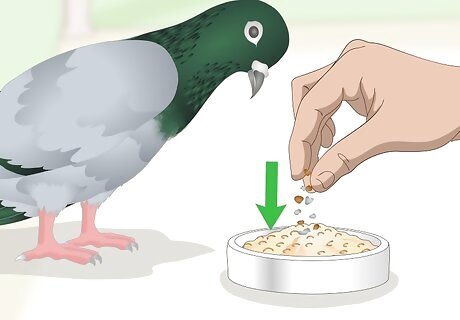
Sprinkle grit over grains to help pigeons digest food. Pigeons are said to use grit the same way other birds, such as chickens, do. You can buy bags of grit online or at feed stores. Eggshells and oyster shells may also be used. Prepare your own grit by baking and smashing eggshells or oyster shells. You only need to mix a small amount of grit to the food, about 0.15 oz (4.3 g) or less per day. Some quality seed or pellet mixes have grit mixed in. You don’t need to provide additional grit or shells. Check the label first. Using grit may not be necessary. Many feeders believe their pigeons do well enough without grit.
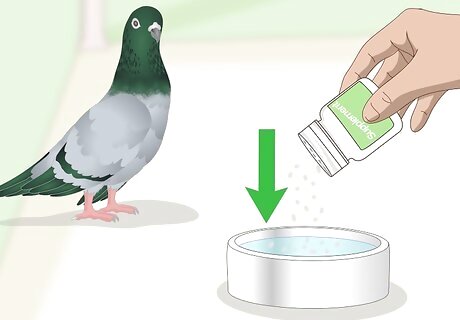
Mix a supplement into drinking water if your pigeons need it. A licensed veterinarian can tell you if your pigeons face nutrient deficiencies. Most birds get everything they need from a balanced diet of grains, fruits, and vegetables. If your pigeon does end up needing extra help, you can purchase a powdered supplement online or at a feed store, then follow the manufacturer’s instructions to find out how much to add to the water. Vitamins and supplements can be added to wet food but should not be applied to dry food like seed mixes. For example, egg-laying pigeons often benefit from calcium gluconate. This supplement replaces the calcium they lose in creating the eggs.
Providing Food to Wild Pigeons
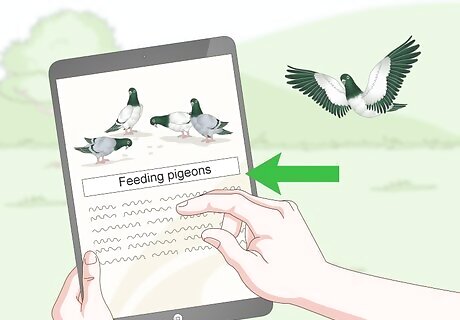
Check that feeding wild pigeons is legal in your area. Pigeons can be found in many cities throughout the world. Some governments aren’t too strict about feeding them but have a few regulations in place. You can often walk to a park and throw out some grains without anyone batting an eye. For example, feeding pigeons is legal in New York City but illegal in San Francisco as of 2018. Feeding pigeons can attract more of them and make them dependent on humans. Take care if you feed pigeons from a building, such as on a rooftop or from a hanging feeder. Their droppings can cause a mess which can also get you into trouble with the law.
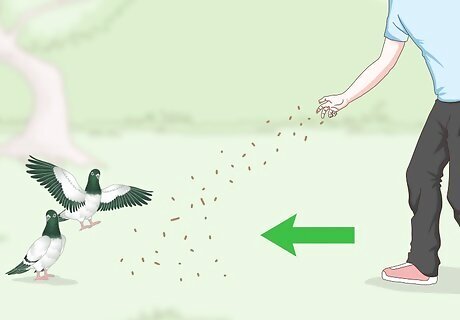
Scatter a small amount of food away from you. Many people may have the same idea as you, meaning that pigeons can stuff themselves silly over the course of the day. Feeding pigeons is fine, but you don’t need to give them a lot. Try to limit the food to no more than 1 oz (28 g) each of a grain blend and a fruit and vegetable blend per bird. Less is more. If you can, spread out the food between different pigeons. This shouldn’t be much of a problem unless you try bringing a massive bag of seed to the park. Commercial grain or pellet blends are ideal foods due to their nutrition. Plain popcorn and rice are good, but bread isn’t and neither is processed junk food.
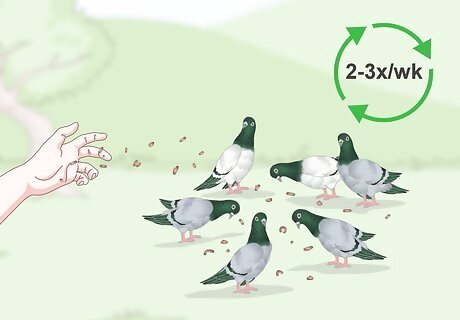
Provide food for pigeons no more than every couple of days. Providing lots of free food to pigeons can be a problem for everyone in your area. To avoid trouble, limit your feeding sessions to no more than 2 or 3 times a week. This prevents large, damaging flocks of pigeons from forming. Feeding pigeons can become a ritual. It’s understandable, but try not to get too attached. Remember your surroundings. Parks and city streets are places where pigeons gather, but avoid crossing onto private property.
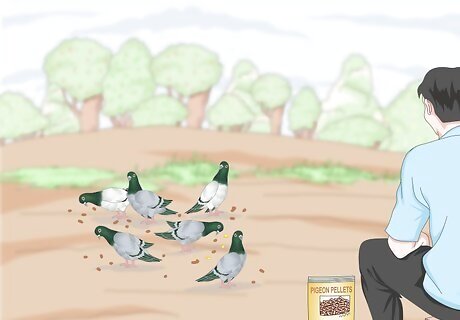
Visit different locations while feeding pigeons. Pigeons recognize a meal ticket. If you show up at the same bench every day, you will soon find a flock of pigeons waiting for you. This is bad for them because they become dependent on you. If you feed pigeons often, vary up your routine to avoid this dependency. Preventing flocks of pigeons from gathering will keep you out of trouble, too.
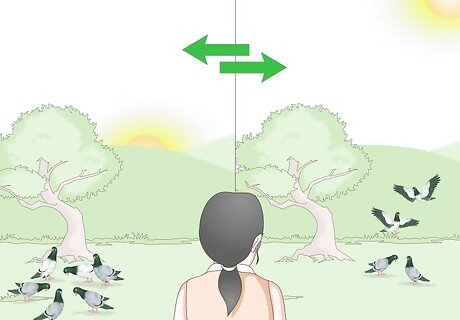
Visit the pigeons at different times. For the same reasons you should visit different locations, you should avoid going to areas at the same time each day, if possible. Pigeons quickly get accustomed to your routine when you show up in front of them like clockwork. Surprise the pigeons by going out in the morning instead of the afternoon sometimes, for example. If you don’t feed the pigeons every day, going to the same location at the same time of day won’t be as much of a problem. However, the begging faces may make you feel bad. Resist the temptation to feed them!
Caring for Pigeons at Home
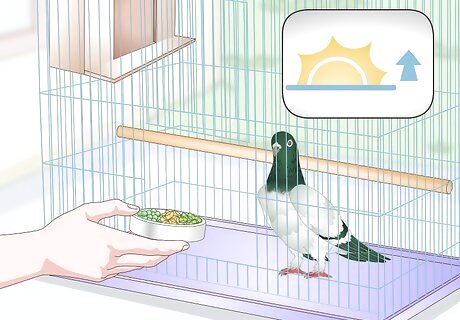
Feed pigeons in the morning. Pigeons only need to be fed once a day. They won’t eat all of the food at once. Instead, they nibble on it throughout the day. As long as you provide all of the food they need for the entire day, you don’t need to do much else. Provide the food in a clean bowl or plastic container.
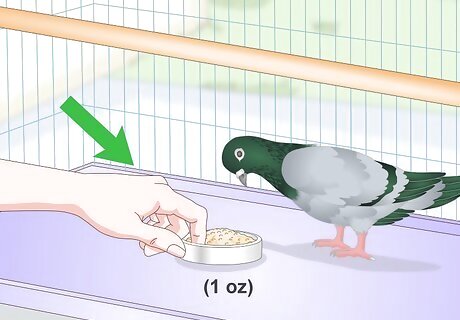
Give each bird about 1 oz (28 g) of grain. A pigeon needs approximately 2 tablespoons (29.6 ml) of a seed or pellet mix per day. This is an estimate, so your pigeon may end up leaving a lot of food in the bowl at the end of the day. Consider this a starting point when figuring out how much food to provide. This estimate is per pigeon. If you have multiple pigeons, each bird should get this amount of food. You can put it all in a single bowl.

Check the bowl to see how much food is left over at sunset. Sunset is when you can expect your pigeons to stop eating. At this time, you should take the food out of the cage. Dump it out and clean out the bowl. However, if you notice a lot of food left in the bowl, chances are you are giving your pigeons too much. Pigeons are pretty smart, so they have a tendency to pick out the tastiest parts of their food. They like high-fat components such as safflower seeds in their blends, but if they don’t eat the rest of the mix, they don’t get all the nutrients they need.
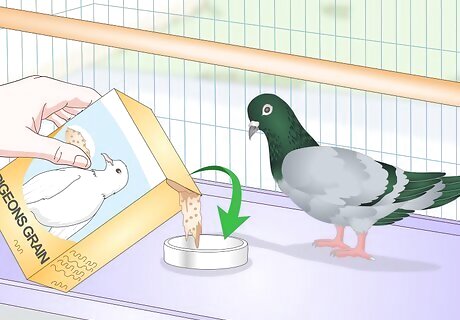
Feed your pigeons fresh food every morning. You should refresh the food bowl with a fresh grain blend every day. Do it early in the morning so your pigeons get all of the nutrients they need for the day. Avoid feeding them old food that sat in the bowl overnight. Offering fresh food avoids the risk of mold or other diseases creeping into the grain.
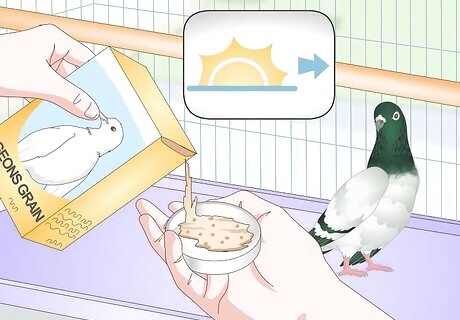
Lower the amount of grain you give the pigeons the next day. Your goal is to get your pigeons to eat all of the food in the bowl by sunset. Fill the bowl with your seed or pellet blend, this time giving them a little less than you gave them the day before. Check the bowl again at night to see what is left over. Continue lowering the amount of food every day until it is all gone. This will ensure your pigeons stay healthy without being overfed.



















Comments
0 comment